|
|
|
Sort Order |
|
|
|
Items / Page
|
|
|
|
|
|
|
| Srl | Item |
| 1 |
ID:
133594


|
|
|
|
|
| Publication |
2014.
|
| Summary/Abstract |
In the years since the hostilities in Sri Lanka ended in 2009, the understandable international focus on the evidence of war crimes by both sides has diverted attention from certain other questions that emerge from the 26-year conflict between the Liberation Tigers of Tamil Eelam (LTTE) and the Sri Lankan government. Here I briefly explore three general questions that have arisen not only in Sri Lanka but also in many other modern conflicts, including those characterised by what is variously called asymmetric warfare, violent extremism or terrorism.
|
|
|
|
|
|
|
|
|
|
|
|
|
|
|
|
| 2 |
ID:
133602
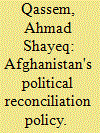

|
|
|
|
|
| Publication |
2014.
|
| Summary/Abstract |
The Afghan government's peace and reconciliation overtures to the militants, initially at the unofficial level but later sanctioned officially, have formed a key theme of state security policy from the early days of the post-Taliban administration in Afghanistan. Yet far from producing peace and stability, they seem to have played into the hands of the violent groups intent on overthrowing the country's internationally supported and legitimate political system in the past decade. There is no doubt about the importance of national reconciliation as a wider process of overcoming the legacy of beleaguered social relationships and forging a common vision for the future among all Afghans, but the nature of the government's reconciliation policy, which borders on appeasement of the militants, seems so far to have created more vulnerabilities than strengths in the face of increasingly emboldened anti-state violent groups.
|
|
|
|
|
|
|
|
|
|
|
|
|
|
|
|
| 3 |
ID:
133600
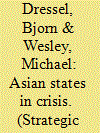

|
|
|
|
|
| Publication |
2014.
|
| Summary/Abstract |
Problems common to many Asian states suggest a pattern of crisis in Asia. The evidence suggests that the root cause is the similarity in the patterns of political development of postcolonial states. In Asia such states have attempted to reconcile state strength and internal diversity by constructing a triangular balance between identity construction, hegemonic governance and economic development. Unfortunately, this fragile balance eroded as state structures matured and economies grew, which increasingly exposed countries to escalating crises of legitimacy and instability. By highlighting changes in the postcolonial state compact within the region, this article seeks to advance both the understanding among theorists of political developments in the region and the understanding among those who govern of the roots of the current crisis.
|
|
|
|
|
|
|
|
|
|
|
|
|
|
|
|
| 4 |
ID:
133611
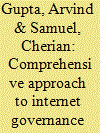

|
|
|
|
|
| Publication |
2014.
|
| Summary/Abstract |
The pressing issues around cyberspace revolve around internet governance, cybersecurity and drawing up rules of the road for the new domain of cyberwar. While each of these is at a different stage in its evolution cycle, cyberspace itself is facing a watershed moment as insecurities mount. The fragmentation of cyberspace seems inevitable unless there is accelerated movement on resolving the fundamental issues of internet governance and cybersecurity that have been hanging fire for well over a decade.
|
|
|
|
|
|
|
|
|
|
|
|
|
|
|
|
| 5 |
ID:
133612
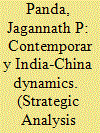

|
|
|
|
|
| Publication |
2014.
|
| Summary/Abstract |
This review essay examines the significance of India-China relations against the background of the current phenomenon of a multipolar world in the light of four recent publications on the subject. Tien-sze Fang's and Jeff M. Smith's works discuss the current facets of India-China relations, while William Antholis's and Carl J. Dahlman's works deal with the character and standing that India and China bring to their regional and global discourse. After reviewing the core of these books, this essay will seek to locate the dialogue and import of India-China relations in two constructive settings: first, the versatility of this relationship in a multipolar world order; second, why this relationship is important to the future of multipolar world politics. In the official idiom, India-China dynamics are not confined to the bilateral ambience. For example, a joint statement issued on the occasion of the visit of Premier Li Keqiang to India (May 20, 2013) records that 'There is enough space in the world for the development of India and China … As the two largest developing countries in the world, the relationship between India and China transcends bilateral scope and has acquired regional, global and strategic significance'.1 This official endorsement comes against the background that the year 2014 is the 60th anniversary of the occasion when the Panchasheel discourse was first enunciated.
|
|
|
|
|
|
|
|
|
|
|
|
|
|
|
|
| 6 |
ID:
133607


|
|
|
|
|
| Publication |
2014.
|
| Summary/Abstract |
Cyber terrorism is a phenomenon that is gaining more and more attention. One reason for this is the concern that modern information and communications technology may be used in order to harm open societies. This concern also involves actual IT systems and the information generated being targets of advanced attacks. That way functions that are important to society could be affected. The term 'cyber terrorism' is complex. This article describes the difference between traditional and cyber terrorism. The main focus is on how the al-Qaeda terrorist network acts in cyberspace and how their change in concentration and activities has made them a clever player in an electronic Jihad.
|
|
|
|
|
|
|
|
|
|
|
|
|
|
|
|
| 7 |
ID:
133609
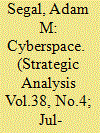

|
|
|
|
|
| Publication |
2014.
|
| Summary/Abstract |
In June 2013, President Obama met with President Xi Jinping at Sunnylands, California. The meeting was seen as a chance for the two leaders to get to know each other in a relatively informal setting so they could address the growing mistrust between their countries. While maritime disputes, trade tensions and differences over how to contain the North Korean and Iranian nuclear programmes were high on the agenda, cyber security-in particular Chinese cyber espionage-was the defining issue of this unusual summit. For the US, the meeting between the two presidents was the culmination of a long campaign to pressure Beijing to reduce the scope and scale of Chinese cyber attacks on the United States.
|
|
|
|
|
|
|
|
|
|
|
|
|
|
|
|
| 8 |
ID:
133610
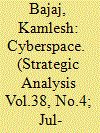

|
|
|
|
|
| Publication |
2014.
|
| Summary/Abstract |
Just as the world was beginning to understand the various dimensions of cyberspace in general, and internet governance in particular, it received the rude shock of the Snowden revelations about the global surveillance carried out by the United States National Security Agency (NSA) in the name of counterterrorism. All kinds of electronic communications of US citizens and non-citizens alike were monitored. Phone tapping and electronic interception were part of this huge operation to collect a haystack of data in the hope of detecting terrorist links to protect national security. The stories that are emerging from the NSA documents made available by Edward Snowden since June 2013 in the Guardian, the New York Times, Der Spiegel and the Washington Post continue to surprise, enrage or shame people depending upon the nation or group that they belong to. The whole world, including those who work for spy agencies, is surprised at the enormity of the scale of surveillance.
|
|
|
|
|
|
|
|
|
|
|
|
|
|
|
|
| 9 |
ID:
133596
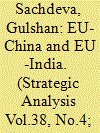

|
|
|
|
|
| Publication |
2014.
|
| Summary/Abstract |
More than a decade has passed since the European Union (EU) signed strategic partnerships with China (2003) and India (2004). The EU's 'honeymoon' with China was over within a few years while cooperation on truly strategic issues with India is yet to emerge. The core of both these relationships is still economics. While China has taken full advantage of the EU's institutional mechanism through more than 56 sectoral dialogues to promote its geopolitical goals and also to neutralise European concerns about democracy and human rights, Indian policy makers and analysts remain sceptical about Europe's role in global affairs. As a result, they have not bothered to use European capacities to promote their own interests through this partnership.
|
|
|
|
|
|
|
|
|
|
|
|
|
|
|
|
| 10 |
ID:
133597
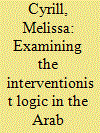

|
|
|
|
|
| Publication |
2014.
|
| Summary/Abstract |
At first glance, there was no coherent regional and international response to the transitions triggered in the Arab world since December 2010 as external players, both regional and international, had to confront with unceasing alarm the rapidity of change threatening to unravel in critical Arab states. However, as events in the region progressed, a pattern emerged to the external responses, one that was as predictive as it was differentiated. This was exemplified by the counter-revolutionary forces that were assembled against the transition in Bahrain on one hand, and the aggressively interventionist posture adopted towards Libya and Syria on the other. This inconsistency between activism and support for the supposedly democratic spirit of armed resistance groups, but inaction and silence towards the crushed non-violent public opposition elsewhere, clearly betrayed the interest-driven motivations of the external actors involved.
|
|
|
|
|
|
|
|
|
|
|
|
|
|
|
|
| 11 |
ID:
133605
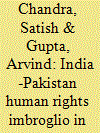

|
|
|
|
|
| Publication |
2014.
|
| Summary/Abstract |
It is relevant to recall the background to Pakistan's move to introduce this resolution. India was in a very difficult situation at the time. Kashmir was in flames due to a strong militant movement aided and abetted by Pakistan. Confrontation between the security forces and militants was an all too frequent occurrence. Moreover, India was far from being a rising power as is the case today. It had a minority government fighting for survival, hard put to address a myriad of serious problems like the demolition of the Babri Masjid and the subsequent Mumbai riots with an economy on the brink of bankruptcy. You would remember that a couple of years earlier, we had to mortgage gold to keep our economy afloat and India's diplomatic standing was, perhaps, at its lowest ever at that point in time. With hindsight, it is obvious that Pakistan had orchestrated its move to mount a resolution against us on Kashmir in tandem with its promotion of militancy there, so as to internationalise the issue and push us to the corner at a time when we were at our weakest.
|
|
|
|
|
|
|
|
|
|
|
|
|
|
|
|
| 12 |
ID:
133604


|
|
|
|
|
| Publication |
2014.
|
| Summary/Abstract |
This article describes India's energy situation in the midst of current economic and geopolitical challenges while highlighting some of the key issues pertaining to India's natural gas infrastructure. The infrastructure dealt with in this article includes natural gas grids (networks of natural gas pipelines) and Liquefied Natural Gas (LNG) terminals which are planned to be expanded further, as well as transnational gas pipelines from and through countries like Iran, Turkmenistan, Myanmar, Pakistan, Afghanistan and Bangladesh, which have been pursued by the Indian government for a long time. Other infrastructure such as city gas distribution, consisting of Piped Natural Gas (PNG) for domestic and commercial use and Compressed Natural Gas (CNG) for use in automobile industries, remains outside the scope of this article. The article further highlights how such an energy situation coupled with poor natural gas infrastructure has deepened India's energy crisis, characterised by poor performance of the power sector, particularly those run on natural gas. It gives some recommendations for improving such infrastructure and better gas diplomacy for its transnational gas pipelines which could lead to better and faster distribution of natural gas across the country. The article also highlights the preferred course of action for the government, besides offering policy prescriptions in due course.
|
|
|
|
|
|
|
|
|
|
|
|
|
|
|
|
| 13 |
ID:
133598
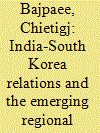

|
|
|
|
|
| Publication |
2014.
|
| Summary/Abstract |
South Korean president Park Geun-hye visited India in January 2014 after India and South Korea marked 40 years of diplomatic relations the previous year.1 These developments symbolise a burgeoning relationship between two of Asia's leading economies and democracies. However, they have added significance as Asia undergoes a shift in the strategic balance of power. This has been prompted by the US rebalance or strategic pivot towards Asia, the rise of China and its proclivity to adopt a more assertive position on regional issues, and the emergence of the 'Indo-Pacific' as a new geopolitical frame of reference. In this context, rising Asian powers such as India and South Korea hold an increasingly significant place in meeting the region's development and security objectives.
|
|
|
|
|
|
|
|
|
|
|
|
|
|
|
|
| 14 |
ID:
133595
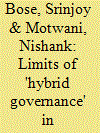

|
|
|
|
|
| Publication |
2014.
|
| Summary/Abstract |
The following commentary argues that the strategic and structural solutions proffered by advocates of 'hybrid' governance-encompassing elements from distinctly different ideological backgrounds or schools of thought-ignore or fail to address certain inherent shortcomings in their approach that are counter-productive to the ongoing and long-term statebuilding and peacebuilding projects in Afghanistan. The following study elucidates some of these shortcomings.
|
|
|
|
|
|
|
|
|
|
|
|
|
|
|
|
| 15 |
ID:
133601
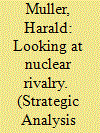

|
|
|
|
|
| Publication |
2014.
|
| Summary/Abstract |
The 100th anniversary of World War I is a reminder of the risks of great power politics. The current dynamics of world politics rest on the relations among the US, China, Russia and India, and their interlocking relations with friends and enemies in a region that extends from the Gulf to the Japanese archipelago. A naval and nuclear arms race is underway that reflects these complex relationships. One of the numerous disputes could spread conflict across the whole region. This risk includes the nuclear factor. A three-pronged effort including political detente, arms control and nuclear disarmament is needed to defuse these dangers, which will otherwise continue to grow.
|
|
|
|
|
|
|
|
|
|
|
|
|
|
|
|
| 16 |
ID:
133608
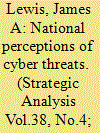

|
|
|
|
|
| Publication |
2014.
|
| Summary/Abstract |
The issue of cybersecurity as an issue for international security has captured the attention of policy makers around the world. A 2011 United Nations (UN) assessment found that only 68 of the 193 UN member states had cybersecurity programmes. By 2012, this had increased to 114 countries. Of the nations with cybersecurity programmes, roughly 40 have publicly identified cybersecurity as a military concern in national military strategies or defence white papers.
|
|
|
|
|
|
|
|
|
|
|
|
|
|
|
|
| 17 |
ID:
133599
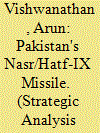

|
|
|
|
|
| Publication |
2014.
|
| Summary/Abstract |
On November 5, 2013 Pakistan conducted its fourth test of the Hatf-IX (Nasr) short range battlefield 'nuclear' missile. To date there have been four flight tests of the missile system. After the first three tests (April 19, 2011, May 29, 2012 and February 11, 2013) Pakistan's Inter Services Public Relations (ISPR) had put out identical press releases.1 These statements claimed that the missile had a range of 60 km and carried 'nuclear warheads (sic) of appropriate yield'. The ISPR statement following the fourth flight test of Nasr, a salvo firing of four missiles, was worded differently and did not repeat the claim that Nasr carried a nuclear warhead. Curiously, it referred to the missile's nuclear capability in a roundabout sort of way. The statement claimed that the missile 'contributes to the full spectrum deterrence against threats in view of evolving scenarios'.2
|
|
|
|
|
|
|
|
|
|
|
|
|
|
|
|
| 18 |
ID:
133603
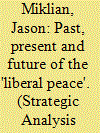

|
|
|
|
|
| Publication |
2014.
|
| Summary/Abstract |
The stunted and stumbling progress of the 'liberal peace' philosophy since 1990 tells a complex story. In this article, I give a history of the liberal peace project from its academic and activist origins to today's global application, discussing how policymakers and liberal peace architects see liberal peacebuilding, and how emerging powers such as India and China relate to these goals. I close with a discussion of the future of liberal peacebuilding, the 'Business for Peace' paradigm and how relationships between powerful states and their peripheries will still matter despite a more consolidated international aid community.
|
|
|
|
|
|
|
|
|
|
|
|
|
|
|
|
| 19 |
ID:
133606
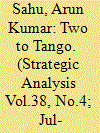

|
|
|
|
|
| Publication |
2014.
|
| Summary/Abstract |
In the last decade, the dynamics of inter-state relations in the Asia Pacific have changed rapidly, largely due to the rise of China. Competition rather than cooperation has become the order of the day. In the East and South China Seas, freedom of navigation, competitive claims over maritime boundaries and air space security are experiencing an evolution of new brinkmanship between the US, an established super power, and the People's Republic of China (PRC), an emerging super power, unfolding new challenges for the other potential regional players including India.
|
|
|
|
|
|
|
|
|
|
|
|
|
|
|
|
|
|
|
|
|